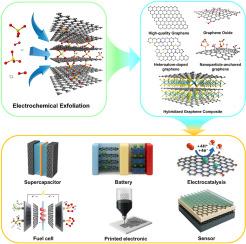A comprehensive review of electrochemical exfoliation of graphite for tunable graphene architecture: Mechanistic insights, design principles, functional derivatives, and emerging applications
IF 11.6
2区 材料科学
Q1 CHEMISTRY, PHYSICAL
引用次数: 0
Abstract
Graphene has attracted considerable attention owing to its exceptional physical and chemical properties, which support a wide range of scientific and technological applications. Although numerous synthesis methods have been developed for scalable production, many conventional techniques involve high temperatures, hazardous reagents, or complex processing steps. As a more sustainable and efficient alternative, electrochemical exfoliation has emerged as a promising approach for graphene synthesis. This review provides a comprehensive overview of electrochemical exfoliation, including its fundamental principles, underlying mechanisms, and the tunability of graphene properties through controllable process parameters. Furthermore, its utility in the synthesis of graphene derivatives and composite materials is discussed, thereby broadening its applicability across various research domains. Recent advances in energy-related and sensing applications are examined, alongside current challenges and future perspectives for establishing electrochemical exfoliation as a practical and scalable method for producing high-quality graphene.

全面回顾石墨的电化学剥离可调石墨烯结构:机械见解,设计原则,功能衍生物和新兴应用
石墨烯由于其特殊的物理和化学性质而引起了人们的广泛关注,这支持了广泛的科学和技术应用。虽然许多合成方法已经发展为规模化生产,许多传统的技术涉及高温,危险的试剂,或复杂的处理步骤。作为一种更可持续和高效的替代方法,电化学剥离已成为一种有前途的石墨烯合成方法。本文综述了电化学剥离的基本原理、潜在机制以及石墨烯性能可通过可控工艺参数的可调性。此外,还讨论了其在石墨烯衍生物和复合材料合成中的应用,从而扩大了其在各个研究领域的适用性。研究了能源相关和传感应用的最新进展,以及建立电化学剥离作为生产高质量石墨烯的实用和可扩展方法的当前挑战和未来前景。
本文章由计算机程序翻译,如有差异,请以英文原文为准。
求助全文
约1分钟内获得全文
求助全文
来源期刊

Carbon
工程技术-材料科学:综合
CiteScore
20.80
自引率
7.30%
发文量
0
审稿时长
23 days
期刊介绍:
The journal Carbon is an international multidisciplinary forum for communicating scientific advances in the field of carbon materials. It reports new findings related to the formation, structure, properties, behaviors, and technological applications of carbons. Carbons are a broad class of ordered or disordered solid phases composed primarily of elemental carbon, including but not limited to carbon black, carbon fibers and filaments, carbon nanotubes, diamond and diamond-like carbon, fullerenes, glassy carbon, graphite, graphene, graphene-oxide, porous carbons, pyrolytic carbon, and other sp2 and non-sp2 hybridized carbon systems. Carbon is the companion title to the open access journal Carbon Trends. Relevant application areas for carbon materials include biology and medicine, catalysis, electronic, optoelectronic, spintronic, high-frequency, and photonic devices, energy storage and conversion systems, environmental applications and water treatment, smart materials and systems, and structural and thermal applications.
 求助内容:
求助内容: 应助结果提醒方式:
应助结果提醒方式:


